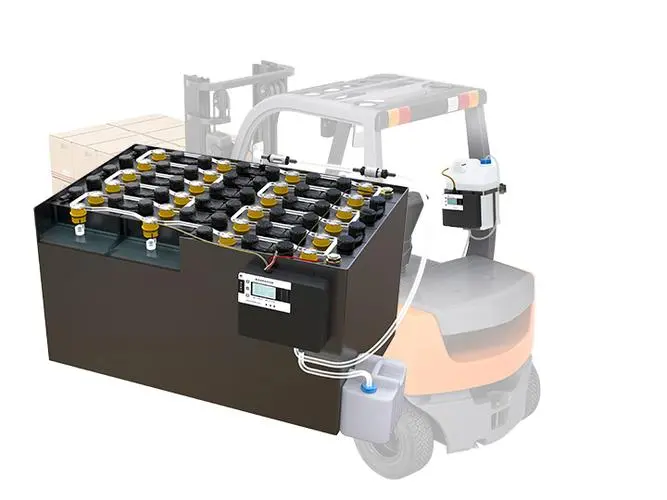Electric forklifts, despite their higher upfront cost compared to internal combustion forklifts, offer significant long-term savings. Their energy costs are less than half of those for combustion forklifts over their lifespan. As labor costs rise, electric forklifts are becoming increasingly popular among business owners.
However, many business owners lack sufficient knowledge about maintaining the batteries of their electric forklifts. A critical aspect of this maintenance is adding water to lead-acid batteries, which many are unaware of. Neglecting this can drastically shorten battery life, leading to losses exceeding 40% of the battery’s value.
Why Do Forklift Batteries Need Water?
- Electrolysis During Charging: As the battery charges, especially nearing the gassing stage, water in the electrolyte is electrolyzed into hydrogen and oxygen gases, reducing the electrolyte level and increasing its concentration.
- Electrolysis During Discharging: Although less intense than during charging, discharging also causes water loss, especially during high-current, continuous discharge.
- Electrolyte Splatter: Vigorous electrochemical reactions can cause the electrolyte to splatter out if the level is too high. This results in loss of sulfuric acid along with the water, altering the electrolyte’s density and affecting battery performance.
How to Properly Add Water to Forklift Batteries
Confirming Water Needs
First, check if the battery is low on water. The electrolyte level should be at least 10mm above the lead plates. If it’s below this, distilled water or deionized water must be added.
Adding Water
- Preparation: Ensure proper protective equipment, such as safety goggles and gloves, to prevent acid burns.
- Adding Water to Cells: For a 48V battery with 24 cells, add distilled or deionized water to each cell. The electrolyte level should be even across all cells to maintain battery balance.
- Tools: Use a professional watering tool, like a battery watering gun, for precise and safe filling.
Best Practices for Watering
- Water Type: Only use distilled water, not tap or purified water, to prevent contamination.
- Timing: Add water an hour before charging is complete when the electrolyte level is stable.
- Quantity: Fill each cell until the electrolyte level is 1cm above the cell cover. If using a float indicator, fill until the float just rises.
- Frequency: Check electrolyte levels each time the battery is charged. Refill as necessary, typically every week to ten days.
Recommended System
Consider an automatic watering system to ensure timely and adequate watering, especially in busy environments or shift operations. This helps prevent damage to the plates and extends battery life, saving costs in the long run.
Tools for Adding Water to an Electric Forklift Battery
Adding water to an electric forklift battery requires specific tools to ensure safety and precision:
- Battery Watering Gun: This specialized tool allows for precise control over the amount of water added to each cell. It typically features an automatic shutoff to prevent overfilling and can be connected to a water supply or a distilled water container.
- Automatic Battery Watering Systems: These systems can be installed on the battery and connected to a central water supply. They automatically distribute the correct amount of water to each cell, ensuring consistent electrolyte levels and minimizing maintenance time.
- Battery Syringe or Turkey Baster: For manual watering, a large plastic syringe or turkey baster can be used to draw distilled water from a container and dispense it into each cell. This method requires careful attention to avoid overfilling.
- Watering Cart or Jug: Portable watering carts or jugs with built-in pumps can provide a convenient way to transport and dispense distilled water to multiple batteries. Some models come with a hose and nozzle for easier access to each cell.
- Hydrometer: While not used to add water directly, a hydrometer measures the specific gravity of the electrolyte in each cell, helping to determine if water needs to be added and ensuring the electrolyte concentration remains within the optimal range.
- Safety Equipment: Always use appropriate safety gear when handling battery maintenance, including:
- Safety Goggles: To protect your eyes from acid splashes.
- Rubber Gloves: To protect your hands from acid and chemicals.
- Apron: To protect your clothing and skin from acid splashes.
- Distilled Water Container: Ensure you have a clean container filled with distilled or deionized water. Tap water or other types of water can contain impurities that may damage the battery.
Procedure for Adding Water
- Safety First: Wear safety goggles, rubber gloves, and an apron.
- Inspect the Battery: Check the electrolyte levels in each cell. Only add water if the levels are below the minimum indicator.
- Prepare the Watering Tool: Use the watering gun, syringe, or baster to draw distilled water from the container.
- Add Water: Carefully add water to each cell, bringing the electrolyte level up to the recommended mark.
- Check Levels: Ensure that the electrolyte levels are even across all cells.
- Clean Up: Wipe any spilled water or electrolyte from the battery surface.
Conclusion
Maintaining proper electrolyte levels is crucial for the performance and longevity of forklift batteries. Regular and correct watering practices can extend battery life, improve efficiency, and avoid safety issues. Follow the steps outlined above to ensure your electric forklift batteries remain in optimal condition.
